Calabria and Basilicata, close to the heel of the Italian Boot
Calabria has a wonderful “neighbour”: Basilicata (or Lucania, old denomination), the splendid southern landscape where you meet Matera, European Capital of Culture in 2019.
The two regions share the border.
The awesome Pollino mountain range is the natural border line. This is a sequence of mountains among the most beautiful peaks in Southern Italy.
On the north-eastern border, however, the mountain gives way to hills and plains. If we consider the “right arm” of the big gulf of Taranto, the Lucanian shores blend gently with those of Calabria.
There, immediately after the fertile plains of Scanzano Jonico, Policoro, Rotondella and Nova Siri, right there you are in the Province of Cosenza.
Right there, Ionian coast of Calabria begins. It’s the strip of territory that we call the Upper Ionian (Alto Ionio).
Further south, the luxuriant plain of Sibari opens up, known for the green sweep of clementine trees.
Rocca Imperiale
Looking from aerial images, the village of Rocca Imperiale looks like a beehive shaped from the base of the mighty castle.
It is a land extraordinarily “favored” by God, by Mother Nature, where more than 40 direct growers decided to create the Consortium of the PGI Limone di Rocca Imperiale, a very fragrant and very juicy product.
Oriolo
The spectacular Calabrian scenery bordering with Basilicata continues.
It’s time to visit the historical centre of Oriolo. In the magical hinterland of the Alto Ionio Cosentino we find this small village on which stands the medieval castle.
The fortress was owned by the famous Sanseverino family and also by the Pignone del Carretto (Neapolitan origin).
Roseto Capo Spulico
Traveling along the State Road 106 – which runs along the entire Ionian coast – you arrive at the imposing Frederick’s castle at Roseto Capo Spulico.
This is a magical vision on that stretch of road close to the shoreline.
The impressive bulk of the old manor built by king Frederick II, overlooks the coast and the turquoise sea.
Sibari, one of the richest cities of Magna Graecia
Wandering on the ss 106, near the mouth of Crati river, the tourist can visit the most important museum in the Province of Cosenza.
We’re talking about the National Archaeological Museum of Sibaritide.
Here you see amazing collections of finds, we mention above all the magnificent bronze of Toro Cozzante.
The museum structure is surrounded by the archaeological excavation area.
In this site archaeologists agree about the overlap of three distinct cities over the millennia.
The history of the original Magna Graecia Sybaris begins in the eighth century B.C.; then there was the foundation of Thurii, commissioned by Pericles in the fifth century B.C.; finally, chronologically more recent, the protagonist was the Roman colony called Copiae.
Rossano Calabro
the Byzantine cultural hub
In Rossano Calabro we touch – with our own hands – the most precious legacy of Byzantine culture. We are able to admire the Codex Purpureus Rossanensis, a certified World Heritage Site.
The manuscript is very impressive with its formidable miniatures, perhaps from the 6th century AD. It is made up of 188 sheets of parchment containing the entire Gospel of Matthew and almost all of Mark’s.
Corigliano Calabro
the ducal castle
Corigliano Calabro, which today forms a single municipality with Rossano, is pleased to show its beautiful jewel: the ducal castle, one of the best preserved stately homes in Calabria.
In the mid-1800s, Baron Luigi Compagna called Ignazio Perricci from Monopoli, a master who was able to design a fantastic hall of mirrors in the throne room.
Mystery hunters in the Greek Sila:
what are those weird big elephant-shaped stones?
Anyone wishing to venture on the threshold of nearby Presila (and Sila Greca) should not miss the opportunity to see the Stone Elephant up close, in the Campana area.
It is an enigmatic rock formation at the centre of the debate between scholars and mystery hunters.

